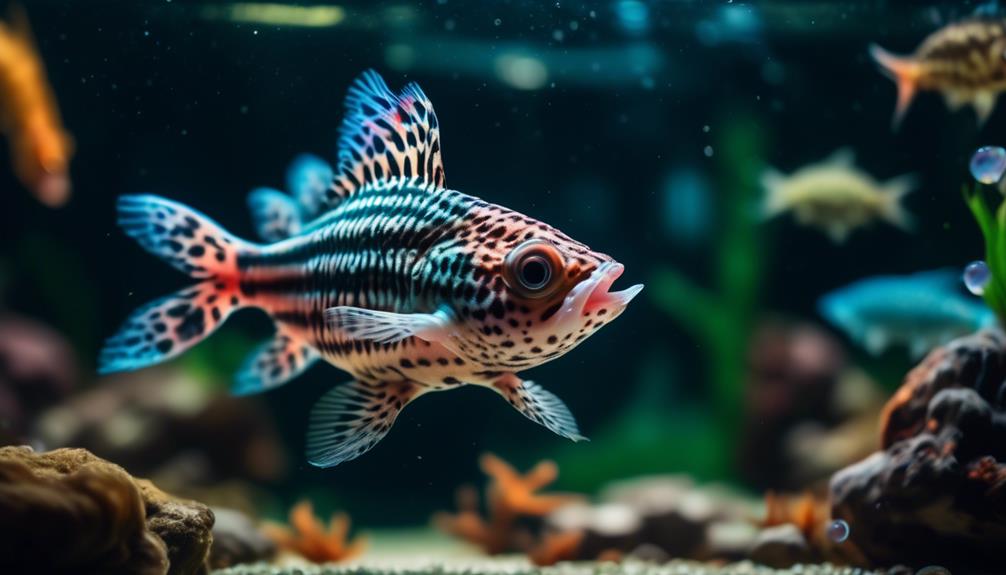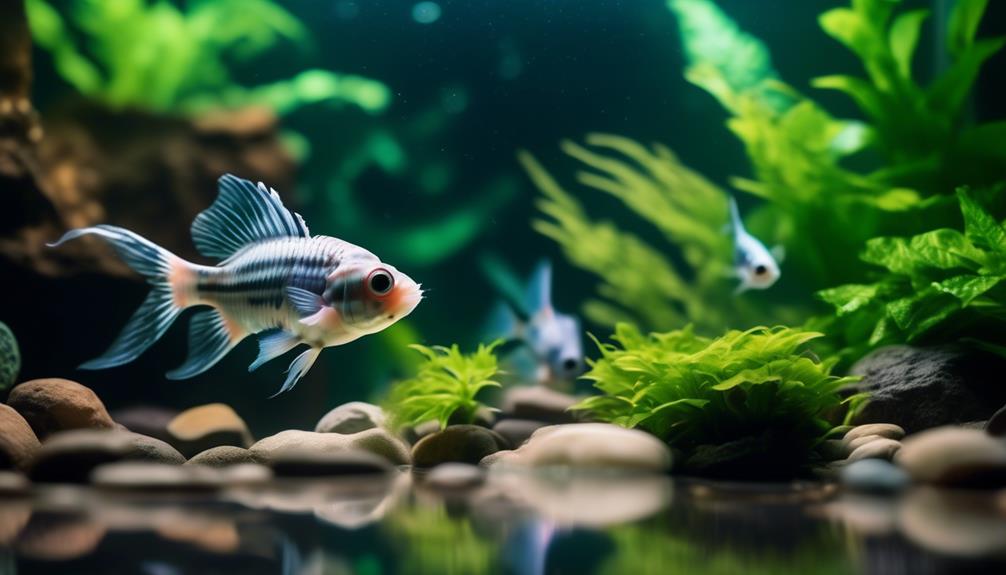Welcome to the enchanting realm of Corydoras species, a realm filled with an array of captivating fish that have captivated aquarium enthusiasts around the globe. These elegant catfish, with their diverse sizes, patterns, and colors, prove to be a delightful addition to any community aquarium.
Known for their calm and peaceful nature, Corydoras thrive when kept in groups, making them ideal companions for a variety of other fish. From the striking Scleromystax barbatus, adorned with its black spotted pattern and golden stripe, to the contrasting beauty of the peppered cory, Corydoras paleatus, this discussion will delve into the world of these exquisite fish, providing insights into their unique characteristics, care requirements, and much more.
So, prepare to embark on a journey filled with wonder and discovery as we explore the captivating world of Corydoras species.
Key Takeaways
- Corydoras catfish come in a variety of species, sizes, patterns, and colorations, making them popular choices for aquarium enthusiasts.
- Keeping Corydoras catfish in groups and in community aquariums is recommended, as they prefer the company of their own kind and can tolerate a wide range of water parameters.
- Some Corydoras species, like Scleromystax barbatus, require more advanced care and specific conditions for breeding, such as lowering pH and softening water.
- Corydoras catfish, such as Corydoras sp. CW010 and Corydoras similis, can be bred for profit, and their eggs can be removed for separate fry raising.
Popular Corydoras Species
Popular Corydoras species are highly sought after for their varying sizes, captivating patterns, and ability to thrive in community aquariums. Some of the popular species include Corydoras sterbai, Corydoras pygmaeus, Corydoras panda, Corydoras aeneus, Corydoras trilineatus, Corydoras similis, and Corydoras paleatus. These species range in size from 1.5 to 3.5 inches and exhibit different patterns and colorations.
Keeping Corydoras in community tanks has several benefits, one of which is their ability to peacefully coexist with other fish. They are also known for their scavenging behavior, helping to keep the tank clean by consuming leftover food and detritus.
Additionally, keeping Corydoras in groups is highly recommended, as they are social creatures that thrive in the presence of their own kind. Grouping them together provides a more natural and comfortable environment, leading to better overall health and behavior.
Unique Characteristics and Care Requirements
Corydoras species exhibit unique characteristics and have specific care requirements that make them fascinating and rewarding additions to an aquarium. Two popular species, Corydoras sterbai and Corydoras pygmaeus, offer distinct features and care needs. Corydoras sterbai, also known as Sterba's Cory, boasts a stunning pattern of black spots on a pale background, while Corydoras pygmaeus, or Pygmy Cory, is known for its small size and peaceful nature. Both species thrive in groups and prefer well-maintained tanks with plenty of hiding spots and soft substrate. On the other hand, Corydoras panda and Corydoras aeneus provide their own unique characteristics. Corydoras panda, resembling a black and white panda, and Corydoras aeneus, available in a bronze variant, are suitable for smaller aquariums and are relatively easy to breed. By understanding the specific care requirements and characteristics of each species, aquarists can create a thriving and visually captivating environment for these exquisite Corydoras.
| Species | Unique Characteristics | Care Requirements |
|---|---|---|
| Corydoras sterbai | Black spots on pale background | – Thrives in groups |
| – Requires well-maintained tanks with hiding spots and soft substrate | ||
| Corydoras pygmaeus | Small size and peaceful nature | – Thrives in groups |
| – Prefers well-maintained tanks with hiding spots and soft substrate | ||
| Corydoras panda | Resembles a black and white panda | – Suitable for smaller aquariums |
| – Relatively easy to breed | ||
| Corydoras aeneus | Available in bronze variant | – Suitable for smaller aquariums |
| – Relatively easy to breed |
Exquisite Corydoras for Advanced Keepers

With their unique characteristics and specific care requirements already discussed, advanced keepers of aquatic species can now explore the realm of exquisite Corydoras that offer an elevated level of sophistication and challenge. These advanced keeper challenges can be met by providing a specialized tank setup tailored to the needs of these species. Here are four crucial considerations for advanced keepers:
- Water Parameters: Exquisite Corydoras species may have specific water parameter requirements, such as lower pH levels or softer water. It is essential to monitor and adjust these parameters accordingly to ensure the health and well-being of the fish.
- Tank Size and Layout: Some exquisite Corydoras species, like Scleromystax barbatus, require larger tanks due to their size and activity levels. Providing ample swimming space and incorporating hiding spots, such as caves or driftwood, will help create a natural and stimulating environment.
- Water Quality: Maintaining pristine water quality is crucial for the health of exquisite Corydoras. Advanced keepers should invest in high-quality filtration systems and perform regular water changes to ensure optimal water conditions.
- Specialized Diet: Exquisite Corydoras species may have specific dietary requirements, such as live or frozen foods. Advanced keepers should be knowledgeable about their nutritional needs and provide a varied and balanced diet to promote their overall health and vitality.
Breeding Corydoras for Profit
Breeding Corydoras catfish can be a lucrative endeavor for experienced aquarists seeking to generate profit. To successfully breed Corydoras, it is important to understand the breeding techniques and tips.
When raising Corydoras fry, it is recommended to provide a separate tank with suitable conditions. The breeding tank should be well-planted with dense foliage to provide hiding spots for the eggs and fry. A soft substrate, such as sand, is preferable to protect the delicate barbels of the adult fish.
Maintaining water parameters within the ideal range, including temperature, pH, and hardness, is crucial for successful breeding. Feeding a varied diet of high-quality foods, including live or frozen foods, will ensure the health and growth of the fry. Regular water changes and proper filtration are also essential for maintaining optimal conditions.
Budget-Friendly Corydoras Options

To cater to aquarists on a budget, there are several affordable options available when it comes to selecting Corydoras species for their aquariums. Here are four budget-friendly options to consider:
- Corydoras aeneus bronze variant: This species offers a budget-friendly option with its bronze coloration. It is a popular choice among aquarists due to its affordability and availability.
- Corydoras paleatus: Known as the peppered cory, this species not only has an attractive pattern of dark and light splotches but also has the advantage of cool water tolerance. It can thrive in temperatures as low as 68°F, making it suitable for aquarists who prefer cooler water conditions.
- Corydoras pygmaeus: This small-sized cory catfish species is perfect for those who have limited space or prefer nano tanks. It can be kept in groups and has the potential to breed in a species-only tank with ample plants and cover.
- Corydoras similis: Another small-sized cory catfish species, Corydoras similis, is rarer compared to other species but can be bred for profit. It requires similar tank conditions as Corydoras pygmaeus and can also be kept in cooler temperatures down to 70°F.
Frequently Asked Questions
What Are Some Common Tank Mates for Corydoras Catfish?
The best tank mates for corydoras catfish include peaceful, non-aggressive fish species such as tetras, rasboras, and small peaceful cichlids. It is important to ensure compatibility in terms of water parameters and feeding habits.
Can Corydoras Catfish Be Kept in a Planted Aquarium?
Corydoras catfish can thrive in a planted aquarium, benefiting from the natural cover and filtration provided by the plants. To maintain a healthy planted tank, ensure proper lighting, substrate, and water parameters, and avoid using sharp or abrasive decorations that may harm the catfish. Regular maintenance, such as pruning and fertilizing the plants, is also essential.
What Is the Lifespan of Corydoras Catfish?
The lifespan of Corydoras catfish can vary depending on factors such as species, diet, and water conditions. On average, they can live for 5-8 years in captivity. They have relatively low care requirements, making them suitable for beginners in the hobby.
How Often Should Corydoras Catfish Be Fed?
Corydoras catfish should be fed once or twice a day with a variety of high-quality sinking pellets or frozen foods. Optimal tank conditions include a well-maintained aquarium with clean water, suitable temperature (around 72-78°F), and adequate hiding places.
Do Corydoras Catfish Require a Specific Type of Substrate in Their Tank?
Corydoras catfish thrive in tanks with soft, sandy substrates that mimic their natural habitat. Fine sand or smooth gravel is ideal, as it prevents injury to their delicate barbels. Avoid rough or sharp substrates to ensure the well-being of these exquisite species.
Conclusion
In conclusion, the world of Corydoras species offers a captivating and diverse array of catfish that are sure to delight aquarium enthusiasts. From the elegant Scleromystax barbatus with its black spotted pattern to the high contrast peppered cory, there is a Corydoras species to suit every preference and skill level.
Whether you're an experienced keeper or just starting out, these unique and beautiful fish provide endless joy and fascination. Dive into the world of Corydoras species and discover the beauty and intricacy of these exquisite creatures.

